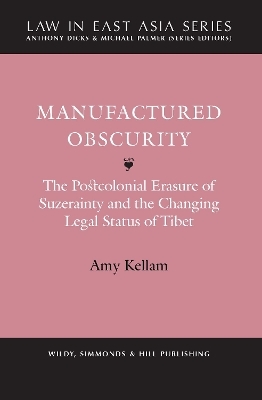
Manufactured Obscurity
Wildy, Simmonds and Hill Publishing (Verlag)
978-0-85490-169-2 (ISBN)
- Titel ist leider vergriffen;
keine Neuauflage - Artikel merken
In 1951 Tibet was incorporated into the People’s Republic of China by the Seventeen Point Agreement. Today the legal status of Tibet remains a matter of contention between the PRC and the Tibetan-Government-in-Exile. Both rely upon on legally ambiguous British engineered treaties to make their case. The inconsistent representation of Tibet’s status in treaties is not, however, a reflection of the ambiguity of Tibet’s status itself; it is a reflection of the ambiguity of such treaties in the context of the positivist-colonial encounter.
Drawing upon British Government archives, this book examines the issue: to what extent, in what ways, and with what effects has the British imperial legacy in the region converged with Chinese formulations of law and governance in Tibet to prejudice understanding of Tibet’s legal status. This addresses a significant gap in international legal literature, which seldom discusses Tibet outside of considerations of minority rights within the PRC.
This book argues that an assessment of imperialism and its relationship with nineteenth century international law is essential to explaining the events of 1951, but it is only through a reassessment of the postcolonial that the absence of discussion of Tibet’s status in international legal discourse can be explained. The history of Tibet’s legal status highlights contradictions embedded within modernity and exposes the mythological foundations of the modern secular state’s narrative of progress.
Manufactured Obscurity concludes that the much emphasised clash between Western and East Asian values in the field of international law in truth operates along a much narrower divide than might be presumed. This is best assessed as a reflection of the contradictions inherent to the postcolonial within international law; involving both a pushing away of the imperialistic past and a reaffirmation of its continuity in order that modern commitments to the rule of law retain value.
Introduction
Chapter One
Introduction
The Tibetan Legal Tradition
The Tibetan Administrative System
Tibetan Relations with the Mongols
Tibetan Relations with the Ming Dynasty
Tibetan Relations with the Qing Dynasty
Tibetan Buddhism at the Qing Court
Chapter Two
Introduction
The Frontier in Qing China
The Unequal Treaty System
British India and Tibet
The Great Game
Beyond the Pass: From Unbounded Empire to Nation State
Chapter Three
Introduction
Modernity as Myth
China’s Engagement with International Law in the Nationalist Era The Standard of Civilisation
The London Conference of 1871
Chapter Four
Introduction
Race and Nation in the Republic of China
Scientific Administration, Modernity and Chinese Nationalism
Chapter Five
Introduction
Tibetan Modernisation
The Simla Convention
Suzerainty in Postcolonial Legal Discourse
The Tibetan Trade Missions
The Tibetan Appeals to the U.N.
The Seventeen Point Agreement and Tibet’s Changing Status in the Postcolonial World
Chapter Six
Introduction
The Seventeen Point Agreement
Regional National Autonomy in the Mao Era
Regional National Autonomy in the Post Mao Era
The 2005 Provisions on the Implementation of the Law of the People’s Republic of China on Regional Autonomy
Chapter Seven
Introduction
Background
The Seventeen Point Agreement (1951-1959)
Democratic Reform (1959-1966)
The Cultural Revolution 1966-1977
Post-Mao Reform Era 1978-1988
Lhasa Unrest 1989 – Present day
Contemporary Constitutional Framework
Subsidiary Legislation Governing Religious Activity
The Religious Affairs Regulations
The TAR Implementing Measures
Problems Arising From the Unique Implementation of National Policy in Tibetan Areas
Managing Religion According to Law
The Management Measures for the Reincarnation of Living Buddhas in Tibetan Buddhism
The MMR in Historical Perspective
Conclusion
Bibliography
Primary Sources
Archive Documents
Legislation
Table of Cases
Table of Treaties
United Nations
Secondary Sources
Index
| Erscheint lt. Verlag | 30.9.2015 |
|---|---|
| Reihe/Serie | Law in East Asia Series |
| Verlagsort | London |
| Sprache | englisch |
| Maße | 152 x 229 mm |
| Gewicht | 555 g |
| Themenwelt | Sachbuch/Ratgeber ► Beruf / Finanzen / Recht / Wirtschaft ► Familienrecht |
| Recht / Steuern ► Allgemeines / Lexika | |
| Recht / Steuern ► EU / Internationales Recht | |
| ISBN-10 | 0-85490-169-8 / 0854901698 |
| ISBN-13 | 978-0-85490-169-2 / 9780854901692 |
| Zustand | Neuware |
| Haben Sie eine Frage zum Produkt? |
aus dem Bereich


